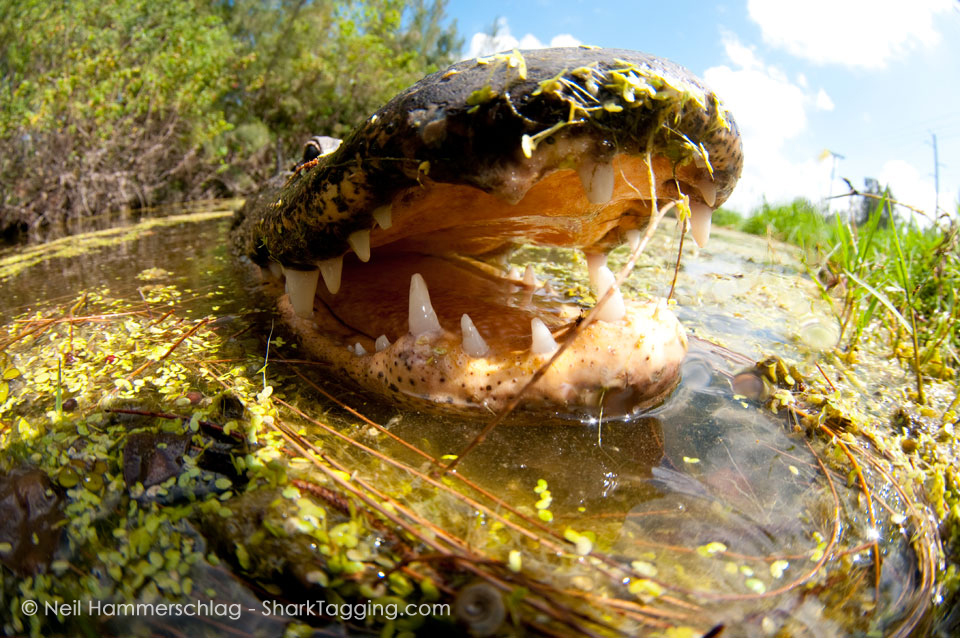My, What Big Teeth You Have!
By Jennifer Simms, SRC outreach intern
The word “shark” conjures up many pictures in ones’ mind. Images range from majestic swimmers in a deep, blue ocean to the lethal rows of teeth easily seen protruding when a shark swims. These teeth serve multiple purposes for both the shark and scientist alike. Scientists study the morphology of teeth, mostly in mammals, to understand how the shape of teeth provides function/purpose to an animal. Most morphological teeth studies have been conducted on the extant (living) mammals and the ancient (well preserved fossilized tooth record). And the tooth can be considered the “fork and knife” for the shark, however, not all teeth are created equal.
In 2010, Lisa Whitenack and Philip J. Motta conducted a study on both living and fossilized species of shark to unlock clues about the variability of teeth shape, structure and function. The authors pointed out that a majority of previous studies have looked at musculature and jaw movement. Whitenack and Motta focused on several goals through the paper focusing on force, cutting performance, and diet. Although the article provided insight into tooth morphology, its focus was on the results found in living sharks.
To address their goals, the authors investigated three general categories of extant teeth from ten species of sharks; 1) tearing-type, 2) cutting-type and 3) cutting–clutching-type. Through a series of tests, they compared teeth morphology and function (functional categories mentioned above) on a variety of soft and hard body prey items, such as fish (soft body) and crustaceans (hard body). Tooth performance was tested by puncture and unidirectional draw. Puncture occurs when a tooth enters at a 90 degree angle to the prey item such as during biting. Unidirectional draw assumes the tooth has already entered the prey, and involves lateral movement through tissue and may occur, for instance, during head shaking.
The results showed differences in puncturing success that occurred among a variety of prey items, indicating that not all ‘soft’ prey items are alike. In some cases, broader triangular teeth (Tooth F, H, and C shown in the chart below) were less effective at puncturing prey than narrow-cusped teeth as shown in the image below (Tooth I, A, and J). Overall, all teeth shapes were able to puncture prey, but not all teeth were designed for tearing flesh in a unidirectional draw or for holding prey in the cutting/clutching role.
Does this mean that scientists can “read” shark teeth and generally determine the function of their teeth? Yes! Here are some examples of sharks that fall into one of the three teeth groups mentioned above, tearing, cutting, cutting-clutching. The Bull, White, and Blue shark all have triangular shaped teeth with serrated edges. This shaped was proven in the article to be less effective at puncturing prey. Instead, the serrated edges of the tooth are like a steak knife and the shark to tear chunks for flesh as outlined in the unidirectional draw. On the other hand, teeth that are narrow and pointy are used for holding prey, such as slippery fish, in the mouth. Sharks with this teeth design are Lemon, Shortfin Mako, and Blacktip shark.
Perhaps now, the word “shark” will inspire the reader to take a closer look at shark teeth design, whether they are observed as fossils on the beach, seen on TV, or view in person in the wild. Practice “reading” shark teeth by using the image below and determine if the shark tooth is designed for cutting and tearing large pieces from prey or is the tooth created to hold prey, such as a whole fish, in the mouth. Those rows and rows of teeth, or fork and knife, are not created equal.
Works Cited
Whitenack, Lisa B., and Philip J. Motta. “Performance of Shark Teeth during Puncture and Draw: Implications for the Mechanics of Cutting.” Biological Journal of the Linnean Society 100.2 (2010): 271-86. Web.

